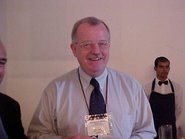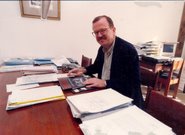




Al Baez, Julia Marton-Lefèvre, Educ Teacher Guides about the World Conservation Strategy and the Rain Forest
Among a range of products EduC developed a multi media pack for teachers on the WCS, a guide on training opportunities for protected area managers and a guide for the formation of wildlife clubs. However the IUCN Secretariat at headquarters expected from EduC what the mass media campaigns had done for WWF. IUCN wanted more support to reach governments and to enable them to influence and change their policies. EduC was perceived not to be up to that task. Al Baez did not stand for re-election.
There were quarrels between IUCN and WWF about education, and also between the IUCN leadership and the EduC Chair. In the meantime much of the conceptual environmental education discourse continued in North West Europe Committee. This committee embarked more and more on its own path. It played an increasingly important role working with its Eastern European counterpart in exchanging ideas and experience across the iron curtain. In 1984 both European Regional Committees held a joint meeting in Helsinki/Espoo, Finland. Al Baez and Julia Marton-Lefèvre acted as chair persons: the beginning of a new East-West cooperation in IUCN.


 Left: Participants of the NWE and EE Committees' joint meeting, Bo, Norway, June 1988, starting to experience the "Take them out" in Norwegian style: a 2 day tour of 40 kilometres in the wild nature of the Telemark mountains. - Photo Jan Cerovsky. Middle: Conference on education for sustainable development for Norwegian educators, organized by the NWE and EE Committees, Bo, Norway, June 1988. John Smyth delivering his lecture. - Photo Josef Velek. Right: Joint meeting of NWE and EE Committees, Bo, Norway, June 1988, opening session. From left to right: Eniko Szalay-Marzso (Chair, EEC), Jan Cerovsky (IUCN Councillor), Chris Maas Geesteranus (Chair, NWEC). - Photo Josef Velek.
Left: Participants of the NWE and EE Committees' joint meeting, Bo, Norway, June 1988, starting to experience the "Take them out" in Norwegian style: a 2 day tour of 40 kilometres in the wild nature of the Telemark mountains. - Photo Jan Cerovsky. Middle: Conference on education for sustainable development for Norwegian educators, organized by the NWE and EE Committees, Bo, Norway, June 1988. John Smyth delivering his lecture. - Photo Josef Velek. Right: Joint meeting of NWE and EE Committees, Bo, Norway, June 1988, opening session. From left to right: Eniko Szalay-Marzso (Chair, EEC), Jan Cerovsky (IUCN Councillor), Chris Maas Geesteranus (Chair, NWEC). - Photo Josef Velek.During the remaining years of the cold war the CEC Eastern European Committee served as an IUCN stronghold in this part of the world, and together with the CLP´s (Commission for Landscape Planning) Committee on Ecological Development of Cultural Landscapes (CECL) based in Central and Eastern Europe, played a vital role in te new IUCN East Europe Programme (EEP). There was a new North American Committee as well, led by Nancy Anderson. This Committee provided support to set up an East African Environmental Network, providing funds for a regional meeting each year. Nathaniel Arap Chumo was one of the key leaders in this network. At the end of the eighties the total membership of EduC was almost 80 members, predominantly from the North and mostly biologists, science educators, pedagogical researchers, teacher trainers etc.




 Gerald Lieberman, M.A. Partha Sarathy, Youth in Environmental Action, A Guide to Environmental Administration In-Service Training, New Ideas in Environmental Education
Gerald Lieberman, M.A. Partha Sarathy, Youth in Environmental Action, A Guide to Environmental Administration In-Service Training, New Ideas in Environmental EducationDuring the eighties the Commission struggled vigorously for its survival, when shortly after his election 1984 as chair Gerald Lieberman (USA,1950) ran into a series of continuing conflicts with the IUCN Secretariat about lack of staff support for the Commission and about UNEP funding for the International Youth Conference on the Environment. In 1986 after consulting Kenton Miller, then DG of IUCN, Dr. Lieberman resigned in favor of Deputy Chair M.A. Parta Sarathy (India,1923). At the General Assembly in Costa Rica in 1988 Partha had the name of the Commission changed to Commission on Education and Training. As IUCN continued its denial of all support to the Commission, Parta Sarathy kept the network going for some time with voluntary support from Dr. Dart Thalman. He then decided to move the CEC Secretariat to Bangalore, India.









4 comments:
First of all, I must congratulate you, Frits and Jan for the fantastic work, which you have put into the "short history" of CEC. The report is well researched and interestingly written, with an excellent commentary and a rich bibliography attached.
Your story mentions most commission secretaries, both those of the early period and after the quantum jump you (Frits) initiated. However, I wonder why Alfred Hofmann and Naseeb Dajani are not mentioned in the text, like the other commission secretaries (or whatever their titles were). For Hofmann it was not easy to follow in the steps of Jan Cerovsky. When I first visited Morges, in 1973 or 1974, hoping to find a useful library on environmental education, I met Hofmann, but I was quite disappointed.
The story about Naseeb is more interesting. The text and even the notes about what happened in 1982 are phrased in quite a "diplomatic" language. Maseeb Dajani is not mentioned by name in the text, only in the notes. He was actually sacked by the IUCN HQ (apparently without informing the commission chairman, Al Baez) for advancing ideas, which today are in the center of IUCN's work, but at the time they annoyed the conservative Conservationists! Naseeb was in favor of linking environmental education with development in the third world – what we now call ESD. Al Baez, himself of Mexican extraction, was furious about Naseeb's sacking and decided to quit as commission chairman.
Abraham
Post a Comment